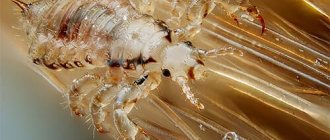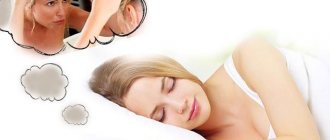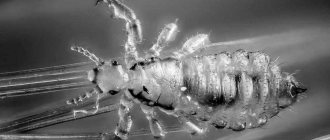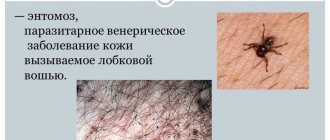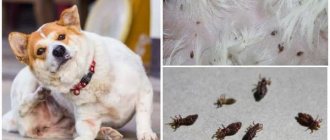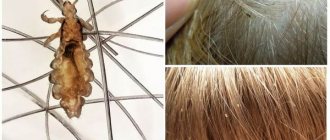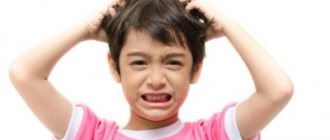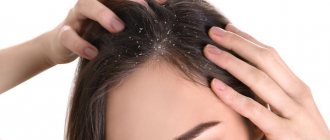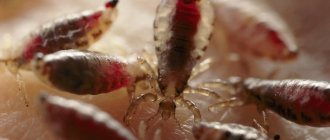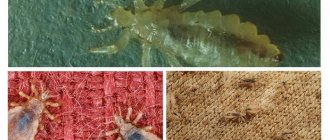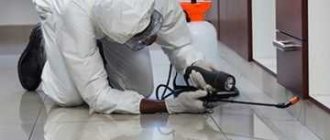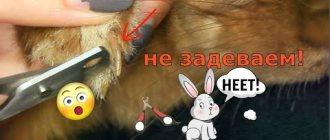- about the author
- VK profile
Svetlana Tarasova
Hairdresser-stylist with more than 8 years of experience, expert in the field of haircuts, styling, hair care, coloring.
Currently, pediculosis is a fairly common disease that affects both children and adults. In this case, the main sign indicating the presence of lice are nits on the hair, from which adult individuals subsequently grow.
How to identify and remove dead nits from hair at home?
Visiting bathhouses and swimming pools, crowded conditions in public transport, trying on hats when purchasing at the market and many other situations in which a person can catch lice.
Capsules from the embryo - what are they?
There are several types of lice in nature, but the most common louse is the head louse. When it lands on a person's head, it begins to quickly lay its eggs #8212; nits, attaching them to the hairs using their glue. Read on our website in more detail about the incubation period of nits and the reproduction of lice.
Often, even after careful treatment, when there are no longer living insects in the hair, dried capsules remain, empty sacs that hold firmly to the hair. These are dead nits. If any are found, then #8212; there were lice that had already hatched.
Sometimes these are full eggs with dead embryos that died without hatching. The fact is that they need a certain temperature and environment to develop, and if they die, it means #8212; found themselves in uncomfortable conditions.
The future larva may also die from treatment with special means, but most drugs are fatal only to hatched individuals.
A nit is a parasite egg. Its embryo lives in a mucous capsule that envelops the hair and is held firmly to it. A dry nit is an egg without a larva that remains in its place for a long time after the young louse emerges.
What dead nits look like, look at the photo below:
Signs of difference between dead and live nits
How can you tell if nits are dead? In appearance, despite its tenacity, a dead nit differs from a living one in several ways:
- dead has a dull gray or whitish color;
- There is no characteristic click when crushing a dead nit.
To check whether it is alive or not, it is removed from the hair by hand or placed on the nail of one finger using a comb and pressed down firmly with the other.
How to remove dead nits from hair?
How to get rid of dead nits? You can remove dead nits using a special comb. Preferably wide. There are many of them available, from conventional to electric. You can purchase any of them at almost any pharmacy. An ordinary comb, due to its structure, will not help much.
It is necessary to follow all the steps correctly, only then will your head become clean and free of lice and their eggs.
- Divide hair into even strands.
- Comb each strand separately.
- Place the treated strand on the side, securing it with a hairpin or clip so that it does not touch the untreated area.
Before applying chemical antiparasitic agents, read the instructions.
ATTENTION! Kerosene and vinegar can burn the scalp. Hellebore water can cause an allergic reaction
Peroxide changes the natural color of hair.
Pharmacy methods of control
The fight against parasites was carried out in Old Egypt. Historians have found evidence of the fact that pediculosis was treated by the priests of the pharaohs.
Methods of getting rid of lice and their offspring can be mechanical or chemical. In the first case, it means washing your hair in hot water at a temperature of at least 55°C, blowing with a hairdryer for half an hour and combing with a special comb.
Special comb for removing lice and nits
Insecticides will be reliable assistants in the implementation of the chemical method, however, they also require further combing.
Mechanical combing
So, if you decide to choose a mechanical method, you will need a plastic comb with very fine teeth or a special device in the form of an iron round comb with a laser notch.
- Wash your hair with very hot water and tar shampoo or soap and dry thoroughly with a hairdryer. Not so long ago, a know-how was released - a hairdryer that can, at a temperature of 55°C, deprive lice of the ability to move, but its acquisition is not targeted if you carry out the function at home with your own hands.
- Lay a snow-white cloth or stationery paper on the floor. Combing is carried out twice a day until the parasites are completely eliminated. This labor-intensive method is difficult to implement on children's hair, but if the child is prone to allergies to chemicals, the above method remains the only probable one.
Chemicals for eliminating lice
Do hair dye kill lice? Yes, but what to do about parasites on children's heads, the answer is in insecticidal products
The choice of one or another product should be done on the advice of a doctor. Most of them are classified as poisonous and should be used accompanied by antihistamines.
On the pharmacy shelf you can find drugs in the form of shampoos, sprays, aerosols, gels, ointments, mixtures and emulsions. The exposure time is determined by the concentration of the product and is indicated in the annotation; almost always the procedure will take from 10 to 40 minutes
After the chemical composition acts on the parasites, they are combed out with a comb with iron teeth. The advantage of such a comb compared to an ordinary plastic one is that the sharp laser notches, collecting the bodies of dead insects, cut through the cocoons of still viable nits (find out here how to get rid of nits in hair).
Any product that you find in your hands does not provide an absolute guarantee, so the function is repeated 2-3 times on days 8, 12, 22.
| Name | Short description | |
| 1 | "Loncid" | The product is available only with a doctor's prescription and is used under his supervision. |
| 2 | Ointment 15% benzyl benzoate | Eliminates lice and larvae. It was found that the ointment can accumulate in the intestinal tract, thereby poisoning the entire body. |
| 3 | Sulfuric ointment | Effective in the fight against head lice, but should not be applied to the scalp. |
| 4 | Aerosol "Spregal" | It is excellent for getting rid of periodic lice, but cannot be used on the scalp. Flammable due to alcohol content. |
| 5 | Aerosol "Para-plus" | The product is applied with an exposure of 10 minutes. Excellent control against parasites due to its neurotoxic effects. |
| 6 | Cream "Nittifor" | Used against head and pubic lice. Unlike the drugs described above, it neutralizes not only adult individuals, but also their larvae. |
| 7 | Solution "Hemerichnaya water" | It is a natural insecticidal agent, has anti-inflammatory and bactericidal properties, and will affect the digestive system of parasites. |
| 8 | "Ivermectin" | One of the few remedies that is taken orally. Its action is aimed at poisoning the respiratory and digestive systems of parasites, so the product is able to cope with both worm lice and head lice. |
Before using the product, be sure to read the list of contraindications
How to get rid of dry (dead) nits on hair
In its development, an adult louse goes through several stages, which in total can last for 2-4 weeks:
- Stage 1 – the female louse lays eggs (nits) approximately 1 mm in size.
- Stage 2 – the larva hatches (this occurs approximately 9 days after the egg appears). Its size is 1.5 mm. This is the first stage of the nymph.
- Stage 3 – the second stage of the nymph begins (1.75 mm).
- Stage 4 – third nymph stage (2 mm).
- Stage 5 – the appearance of an adult male (2.4-3.6 mm) or female (2.3-3 mm).
IMPORTANT. It should be kept in mind that female lice are very fertile and lay 5 eggs (nits) on their hair every day. Having noticed the first signs of the disease, it is necessary to immediately begin treatment
Having noticed the first signs of the disease, it is necessary to immediately begin treatment.
Currently, a fairly large number of methods for eliminating nits are known, ranging from mechanical action to the application of special chemical compounds to the hair.
Combing
This method allows you to remove both living and dead nits. To do this, you must first buy a special comb at the pharmacy. Its distinctive feature is the presence of a large number of thin and frequent teeth, thanks to which the louse egg can be easily removed from the hair.
When combing, you should adhere to the following recommendations:
- the procedure should be carried out in a well-lit room,
- hair should be divided into separate strands,
- for convenience, the head can be slightly moistened or lubricated with oil,
- If your hair is very long, it is recommended to cut it a little.
Medicines
It is immediately worth noting that modern drugs against pediculosis are mainly aimed at destroying adult lice, as well as live nits. The most effective drugs include the following:
- "Nittifor" - used to combat lice, nits, ticks and fleas. Its active component is permethrin, which paralyzes the nervous system of the parasite and leads to their death. Nittifor can be purchased as a cream or lotion,
- "Foxilon" is a hair lotion, the main component of which is benzyl benzoate. This substance easily penetrates the chitinous cover of parasites,
- “Pedilin” is based on the active substance malathion, which causes the death of lice and nits. Available in the form of shampoo or emulsion,
- other drugs against pediculosis.
REFERENCE. After using the above remedies, the remaining dead lice and nits will need to be additionally combed out using a fine-toothed comb.
Folk remedies
Many people faced with the problem of lice often resort to various folk methods. However, you should be very careful here, since the use of this or that substance can be very dangerous.
In addition, folk remedies will also not eliminate dead nits on their own. After destruction, in any case, you will have to comb them out or remove them with your fingers.
So, the main folk remedies against nits include the following:
- treatment of the head with extracts of various plants (for example, a decoction of wormwood, beets, wild rosemary herb, etc.),
- Kerosene mixed with vegetable oil is a fairly effective method of combating nits and lice. However, such a composition can cause severe poisoning of the body, as well as damage the scalp and hair. In addition, kerosene is very flammable,
- vinegar diluted with water - this product makes it easier to comb nits out of hair. However, vinegar will not kill adult parasites. Moreover, if diluted incorrectly, you can burn your scalp.
Treatment of head lice in children has a number of features that must be taken into account:
- Not all drugs are suitable for removing lice from a child’s head. Before use, be sure to read the instructions and ask at what age this or that product can be used,
- in the fight against lice, preference should be given to more gentle methods of action (for example, short haircuts, combing),
- Before using any drug against head lice, it is strongly recommended to consult a pediatric dermatologist or pediatrician.
FAQ
Often, parents faced with the problem of childhood lice have the following questions:
Expert opinion
Eve
hair stylist
Ask a Question
The child was found to have nits, but no lice, why can this happen?
This situation is possible if the infection occurred very recently, that is, only one adult could have landed on the baby’s head, which immediately laid eggs. At the same time, the louse itself (especially if there is one or only a few of them) is quite difficult to notice. This is why it seems to parents that there are nits, but no lice.
Do dead nits click?
As noted above in the text, dead louse eggs do not produce a characteristic click when pressed on them . This is one of the distinguishing features between dead and living nits.
In conclusion, it should be noted that immediately after discovering nits on the head, it is necessary to immediately begin treatment for head lice. It doesn't matter whether they are dead or alive. In any case, lice eggs must be removed from the head.
- about the author
- VK profile
What is a human louse, what types of lice exist?
The immature nits themselves do not pose a threat, with the exception of the unattractive appearance of the hair and white formations in it. But when the louse begins its parasitic life, symptoms appear that can significantly worsen the quality of everyday life. These symptoms include:
- almost constant itching of the scalp;
- infection of scratches and wounds, their infection and suppuration;
- sleep disturbance;
- inability to concentrate;
- irritability, nervousness.
A human louse is a parasite whose biology and lifestyle are unlike any other insect that poses a danger to humans. These pests belong to the genus “true lice”, or “pediculids”. They come in 3 types:
- Head ones. This type of parasite is the most common. As the name suggests, they parasitize on the host’s head, in his hair. Pediculosis is a disease caused by head parasites.
- Pubic. They provoke the development of phthiriasis in adults and (less often) children. The areas of the body that parasites prefer are the pubic area and the area around the anus, armpits, and in men also the chest and abdomen.
- Clothes (linen). This type of real lice, similar in appearance to their head lice, lives in the folds of underwear and bedding and also feeds on blood. They give preference to natural fabrics (cotton, wool).
Short description
Lice (called Anoplura or Siphunculata in Latin) belong to the suborder of ectoparasites and belong to the order Lice. The main source of food for these insects is the blood of the host (human or animal), which they suck after piercing the skin.
Doctors call the disease caused by lice “pediculosis.” In general, 3 types of these parasites most often live on the human body (head) and near it. These include: head, body and pubic lice, which differ in location. Let's describe each of them in more detail.
Looking at it under a microscope
It is hardly possible to see an individual nit in detail without magnification under a microscope: it is too small, only 0.7-0.8 mm in length.
But if you look at them enlarged, you will notice that outwardly the nits look like small capsules due to their slightly elongated shape, 0.4 mm in diameter. The color of nits is whitish-translucent, which is why they are so easy to see on the head, and especially on dark hair.
On the lower part of their body you can see an oblong formation that resembles leaked glue and consists of the same sticky substance that covers the shell. This formation is a kind of “belt”, “fastening” that clasps the hair, thanks to which the nit is held very firmly, and it is not so easy to remove it from the hair.
The upper part of the body is crowned with a flat valve cap, through which a new individual will subsequently “come out into the world.” But this process is not easy for the larva: it cannot crawl out on its own. To get out of the shell, a louse that is ripe and ready for “birth” pushes out the cap and immediately begins to actively breathe. She passes the swallowed air through her digestive tract and releases it from the anus. The amount of released air in the capsule grows and, having reached a certain level of density, pushes the larva out. This process only takes a few minutes.
It is also very difficult to determine by eye whether there is a larva inside the shell or whether the capsule is already empty. By the way, even empty dry capsules will not disappear from the hair, and if they are not removed with special means (for example, acids that weaken the stickiness of the secretion, or thorough combing), then they will leave the head only along with the hair, when the time comes for it to fall out of the head . This sometimes gives the impression that there are many more nits on the head than lice.
We carry out a preventive examination: how long should it be carried out, and how exactly?
4-7 days after the first treatment, be sure to conduct a preventive examination:
- Comb dry hair with a regular comb;
- divide into small strands;
- carefully examine each strand, especially at the back of the head, near the temples, behind the ears;
- make sure there are no parasites of any kind (there shouldn’t even be nits).
We suggest you familiarize yourself with: Table vinegar for nits
This way you will understand that all parasites have been destroyed, or that the treatment will need to be repeated. By the way, if after the first treatment there are still clicking nits on the hair, then they will definitely hatch and lice will start again.
This is why it is so important to comb out parasites: this way you will definitely remove them from your hair, thereby preventing a recurrence of the disease.
Folk remedies in the fight against nits and lice
Pharmaceutical preparations contain chemical components that can cause allergic reactions, therefore, if you do not want to remove lice and nits with medications, then you can try traditional medicine. Folk remedies are completely safe to use and can have a good effect in killing lice and nits. Here are some recipes.
Folk remedies for killing lice and nits
Cranberry or - a good and safe remedy for nits and lice, which should be applied to the scalp and along the entire length of the hair. The concentration of acids contained in cranberry juice weakens parasites and makes them easy to remove from the hair.
Vegetable or olive oil - olive or applied to the hair and wrap the head in a plastic bag. Keep the oil on the hair for 2 hours, then rinse well and comb out the parasites.
Onion or garlic juice - allows you to successfully overcome lice and nits. The action of natural substances contained in onion or garlic juice allows you to dissolve the shells of nits. After applying the product, the hair also needs to be hidden under a plastic bag and kept for about 3 - 4 hours, then rinsed thoroughly and combed out the nits.
Lemon juice - has the same ability as cranberry juice, but unlike cranberries, lemon contains water, which significantly reduces the effect of the product.
- an effective remedy for head lice, which was popular among our grandmothers. To destroy lice and nits, you need to soap your hair with tar soap and put on a plastic bag or a bathing cap for 2 hours. Tar soap contains a large amount of alkali, which poisons the body of parasites.
Hairspray - contains liquid silicone, which blocks oxygen to lice and nits. Just spray hairspray on your hair, cover it with a plastic bag and leave it overnight. In the morning you need to wash your hair and comb out parasites.
Vinegar for lice and nits is a popular method of treating head lice, which was used in ancient times.
Vinegar should be diluted with water in a 1:1 ratio and treated hair and scalp. Then wrap your head with a towel and hold for 20 - 30 minutes. After the time has elapsed, the hair should be rinsed with running water. You need to repeat the procedure after 4 – 5 days
During use, you must avoid contact with mucous membranes; it is also important to dilute the vinegar correctly to avoid skin burns. Acetic acid and hairspray are not recommended for use by children
In addition to the above folk remedies, there are also those whose use can be dangerous to human health, but, nevertheless, some people prefer to use them. Such means include:
Acetic acid and hairspray are not recommended for use by children. In addition to the above folk remedies, there are also those whose use can be dangerous to human health, but, nevertheless, some people prefer to use them. Such means include:
A decoction of tansy flowers is a poisonous plant that must be used with caution so as not to damage the mucous membranes of the eyes. Do not use for pediculosis pubis. Kerosene is a toxic substance that can cause allergic reactions, poisoning, and skin problems
In addition, after using kerosene, the hair becomes greasy and difficult to comb, which does not allow nits to be removed well.
Kerosene is a toxic substance that can cause allergic reactions, poisoning, and skin problems. In addition, after using kerosene, the hair becomes greasy and difficult to comb, which makes it difficult to remove nits well.
Ledum tincture is a poisonous plant that should not be used by children for head lice.
Anti-flea products for pets - flea shampoos for animals do not harm lice or nits in any way, since they do not parasitize pets, but they are quite harmful to humans.
If you are not sure about the correct choice of a remedy for lice and nits, you need to consult a dermatologist, who will definitely suggest the best remedy, taking into account the age and characteristics of the patient’s body.
Use of modern drugs
Most anti-lice products successfully kill lice, but cannot destroy eggs protected by a strong shell.
However, there are drugs that can affect the adhesive substance of the cocoon.
One of these is the “NIT FREE” mousse. Enzymes and surfactants in its composition destroy the shell of nits, which makes them much easier to comb out. The mousse is applied to the hair, and after 5 minutes, without rinsing off the product, you can begin to comb nits out of your hair. This product is quite safe. It can be used to treat children, allergy sufferers and even pregnant women. The drug “Para-plus” has the same properties, but it is contraindicated for children under 2.5 years of age and people suffering from bronchial asthma.
Another modern and effective tool is Neon Nits neon spray for detecting nits. It comes in two versions: pink for dark hair and white for red and blond hair. When the spray is applied to the hair, the nits are painted in the appropriate luminescent colors, which greatly facilitates the detection of parasites. The drug is safe for both children and adults.
How to quickly get rid of lice at home?
Pharmacy drugs
Answering the question - “how to quickly remove lice at home?” — It is necessary to choose a remedy to combat pediculosis
When choosing, pay attention to two main parameters: format and active ingredients
Based on their form, they can be divided into sprays, shampoos and ointments. In general, their effectiveness is the same, but shampoos against lice and nits are more convenient to use, and sprays are useful in that they can be used to treat not only the head, but also clothes and linen. Among ointments, there are very effective and cheap options, for example, sulfur or boric ointment, but they have many contraindications.
People often come to the pharmacy and ask: “how to get rid of lice in 1 day at home?” The most common active ingredients are insecticides and mineral oils. Oils are good because they are gentle on the skin and hair, but products based on them will not remove lice in one use.
REFERENCE! Insecticides are divided into several types; the most effective are preparations containing insecticides from several groups at once, rather than those containing only one type of toxin. Such an effective remedy for head lice and nits can save you from this scourge in one go.
The most commonly used poisons include Permitrin and Malaxion. Let's take a look at what's on the market.
- Hygiene will help remove lice with careful application and subsequent removal. The secret of its effectiveness lies in the acetic acid in the composition, which makes it possible to simplify the most difficult thing in the fight against lice - the destruction of nits.
Paranit is guaranteed to kill lice, but nits are not susceptible to its effects. A controversial choice, but if you use other methods to destroy nits along with using shampoo, then you can purchase it.
Full Marks is an easy-to-use spray with a pleasant scent. But its gentleness to the skin and sense of smell does not make its effect weak - when using the spray together with the comb included, both lice and their eggs will be eradicated.
Medifox is a mixture of alcohol and permitrin. The product must be diluted with water and applied to hair. It has a very strong effect on parasites; official sanitary and epidemiological authorities like to use it.
Medilis super is a strong fenthion-based product. It is used in those extreme cases when other means do not have the desired effect, and removing lice in one day will not be a problem with its help.
Boric ointment is a very strong antiseptic based on boric acid. It eats away small organic matter, which includes lice. But if used incorrectly, it can easily damage the skin and hair.
Our website also contains descriptions and instructions for the use of some other pharmaceutical products: sprays for lice and nits - Nyuda, Paranit, Pediculen Ultra, Benzyl benzoate, Sulfur ointment.
Folk remedies
How to remove lice and nits quickly at home using folk remedies? Many solutions are presented that reliably kill all insects in one application, but can also be used for humans. This includes dust soap and dust concentrate, where the main active ingredient is DDT. Not a single living creature on the head will survive even after superficial application of this poison, but its harm to people and the environment has been proven by scientists.
The same can be said about kerosene. It kills lice, corrodes the attachments of nits to the hair, but its application in a non-concentrated form can cause a burn, and when diluted with water or shampoo, it may not kill the parasites in one application.
A good solution is hellebore water, although it is powerless against nits, it is guaranteed to destroy lice, and subsequently you can comb out nits even from long hair.
In more detail on our website you can learn about the following folk remedies against lice: vinegar, kerosene, dichlorvos, hairspray, essential oils, including tea tree oil, hellebore water, laundry, tar and dust soap.
Disease prevention
Preventing infection is the best way to prevent head lice. You need to know why lice appear and how to prevent their appearance. The result largely depends on awareness and vigilance.
To diagnose head lice in a timely manner, you need to pay attention to unusual symptoms. You should be wary of:
- itching;
- skin redness;
- sudden appearance of “dandruff” (nits).
A close self-examination and seeking medical help will help to quickly solve the problem (if it exists). The sooner treatment is started, the greater the chance of preventing the development of complications.
The main preventative measure for head lice is to limit any close contact with strangers. People with a sloppy appearance greatly increase the danger. The need to be in close crowds of people also poses a risk of infection.
Refusal to use other people's things will increase confidence in the absence of infection. The presence of children in the family is a reason to make it a rule to conduct regular preventive examinations. If characteristic symptoms occur, be sure to do this.
Any suspicious situation is a reason to take preventive measures and consult a doctor. Especially when it comes to contact with people with lice.
To prevent infection, you must stop using other people's things. Be careful with objects in public places - sanatoriums, hospitals, camps, swimming pools, public baths.
It is advisable to refuse to visit those places that do not inspire confidence in terms of the proper level of hygiene. This will provide you with an invaluable service. This applies to hairdressing salons with unscrupulous workers who violate the regulations for processing working tools. The danger lies in low-level hotels, where bed linen is not changed and sanitation is not carried out.
To prevent infection and the development of the disease, the following must be observed:
caution; rules of personal hygiene; preventive measures.
It is important for everyone to know what causes lice. No one is immune from lice
We must try to prevent the invasion of parasites. Otherwise, timely control measures will protect against complications.
Popular methods of combating lice and nits:
- combing out nits from hair;
- how to treat pediculosis during pregnancy;
- tablets for lice and nits;
- natural oils for lice and nits;
- effective folk remedies for lice and nits;
- review of proven shampoos and sprays (lotions) against lice and nits in humans.
Methods for removing insects
How to deal with linen lice? Although the means of control are similar, there are some differences due to the location of the parasite. To quickly and effectively remove body lice, you need to carry out treatment consisting of the following points.
Wash all clothes using disinfectants. Wash bed linen, bedspreads and blankets at a temperature of 80 degrees or more. Iron things using steam
Particular attention is paid to joints and seams. Treat the room with steam or special means
Take a bath, using special anti-parasite shampoos. Disinfect bites. Rub insecticidal preparations into the body.
It is possible to get rid of body lice at home. You should consult a doctor in cases where you cannot cope with parasites on your own. In addition, bite marks can fester and become crusty - then the help of qualified specialists is simply irreplaceable. Such a reaction of the body poses a risk to life, because the infection spreads strongly in the body.
Treatments for ulcers
To relieve swelling, redness and disinfect affected areas of the skin using the following medications:
- Rescuer;
- hydrogen peroxide;
- any ointments and gels that relieve an allergic reaction.
For this purpose, it is recommended to use the following drugs:
- NOC;
- Lauri;
- Veda-2;
- Medifox;
- Buzzed.
Preparations for body treatment
After bathing, in order to discourage insects from drinking blood, the body is treated with essential oils of tea tree or lavender. You won't be able to get rid of linen lice this way, but it will reduce the number of bites.
Processing of things and fabrics
The following products are suitable for treating premises and clothing:
- NOC;
- Medifox;
- Pedilin;
- Karbofos 0.15% emulsion;
Things placed in the solution are boiled or at least rinsed for 30-40 minutes. Such solutions are well suited for wet cleaning indoors.
Development period
A nit is the initial stage of louse development. The louse develops from egg to adult within 2-4 weeks. During this time the following periods are observed:
- egg (nit);
- larval stage;
- 1st and 2nd order nymphs;
- adult parasite.
After a week or a little longer, the nit becomes a larva. The ripening period depends on temperature conditions. So, the most favorable temperature is the human body, that is, 36.6 degrees with minor fluctuations. But if you don’t wear a hat in the cold or the heat is unbearable in the summer, then the life cycle of lice slows down, but does not stop.
Once the louse has emerged from the outer shell of the cocoon, it begins to feed. And literally after 2 days the female is ready to reproduce. During her life, the female lays many eggs - 80-150 nits. Under favorable conditions (air temperature 30), the number of lice increases tenfold in just a few months.
Dry nits, how to distinguish a living nit from a dead one?
Remember the routine head examinations at school. Thirty people in the class and a nurse, enthusiastically delving into pigtails and boyish haircuts. Lightened exhalation - “dry nits”, no signs of lice were found. Otherwise - shame on the whole class, calling parents to school and washing your hair with kerosene or hellebore water.
Pediculosis is a common disease. Even today, a child will become acquainted with these parasites at least once in his kindergarten or school life. But can there be nits without lice? And how to deal with this?
The difference between a dead nit and a living one
A nit is an egg from which a young individual hatches after 5–8 days. During the day, a sexually mature female lays up to 5 of them.
The louse attaches the egg to the hair at a distance of 2.5 cm from the scalp. It is extremely difficult to remove it, since during the process of passing through the fallopian tube of an adult it is treated with an adhesive composition. It is produced by special insect glands. At a distance of 2.5 cm from the body, the temperature regime is ideal for the development of offspring.
Dry nits form after the hatching of a young individual or during the treatment of pediculosis with aggressive insecticides. Dead nits look different than live ones. They are also light in color, but lose their characteristic shine. There is no click when pressing.
Why do they need to be removed?
Currently, effective drugs have been developed that act on adult parasites, nymphs and eggs. But even after treatment, dead eggs remain on the hair. They should definitely be removed. Naturally, they will leave the head only with the hair shaft.
What is the danger of remaining nits?
Dead nits do not pose a threat to the health of children and adults. But this is a foreign protein that can cause an allergic reaction of the skin or respiratory system, since small particles can be easily inhaled.
Psychological trauma poses an additional danger. Other children, seeing parasite eggs in a child's head, may tease and insult him. In addition, no drug provides a complete guarantee of the death of all individuals and eggs of the parasite.
By removing dry nits, you reduce the likelihood of lice surviving and reoccurring.
Messy hair look
With multiple lesions, the hair of a person with head lice looks as if it was sprinkled with fine grains. Nits are visible to the naked eye, so those around him will avoid him. It is useless to prove to people that nits are dry and safe.
Methods for getting rid of dead nits
Removing dead nits from hair is quite easy at home. If you do not use specialized drugs, it will take more time and effort.
Specialized drugs
The pharmaceutical industry produces complex drugs for the treatment of head lice. The active components destroy adults, nymphs and nits, dissolve the glue that attaches the eggs to the hair.
Drugs of choice:
- Permin;
- Lavinal;
- Medilis;
- Couple-plus.
Hydrogen peroxide is not recommended. Treatment with this product helps to separate parasite eggs, but there is a risk of skin burns and damage to the structure of the hair shaft.
Folk remedies
Herbalists suggest using hellebore decoction to remove nits. In pharmacies this medicine is sold under the trade name “Hemerichnaya water”.
A proven and confirmed by official medicine for removing parasite eggs is vinegar. It dissolves the adhesive and the nit is separated from the hair.
In herbalists there are recommendations for treating strands with whole table vinegar. But it is better to dilute it with water in a ratio of 1:10, that is, 100 ml of vinegar is required for 1 liter. Rinse your hair after using insecticides, then comb it out with a fine comb.
Medicines from official medicine will help you quickly and effectively deal with parasites.
To remove nits, use metal combs that come in insecticide kits. The use of untested methods from traditional herbalists is fraught with relapses of the disease, scalp burns and damage to the hair structure.
Safety of procedures
The safest method is mechanical. Any improper use of a chemical or folk remedy will lead to serious problems:
- scalp burn;
- hair loss, deterioration of their condition;
- unpleasant odor that persists even after washing your hair;
- hair bleaching;
- allergic reaction.
To avoid these negative consequences when removing nits, you need to follow safety precautions:
- wear gloves when processing hair;
- strictly follow the manufacturer's instructions for each drug;
- rinse thoroughly with clean water;
- Before using a chemical medicine or folk remedy, conduct a sensitivity test.
Thus, the most effective measure to combat nits in hair will be a combination of mechanical and chemical methods. Instead of medicines, you can use folk remedies
When using them, you must remember safety precautions and the importance of regularly performing procedures
What do dead nits look like?
Have you been fighting against PARASITES for many years without success?
Head of the Institute: “You will be amazed at how easy it is to get rid of parasites just by taking it every day.
The fight against pediculosis is a labor-intensive process that requires increased attention and caution on the part of the patient. After carrying out the necessary treatment procedures, a person needs to know how to distinguish a dead nit from a living one, because the effectiveness of therapy depends on this
The concept of a parasite
Nits are lice eggs, but it would be more accurate to note that they are nothing more than a stage of insect development. They look like small oblong bubbles covered with a membrane. The eggs secrete a sticky liquid, with the help of which they are tightly attached to individual human hairs.
Our readers successfully use Intoxic to get rid of parasites. Seeing how popular this product is, we decided to bring it to your attention. Read more here...
It is noted that the probability of peeling nits from hair even with nails is almost zero. In fact, this option will do more harm than good.
The discovery of some living parasites does not mean that they are resistant to lice preparations; most likely, the product was simply not applied evenly. It is only recommended to repeat the treatment of the affected areas, and then carefully examine the hair and scalp again.
Dead nits
Before getting rid of dead parasites, you need to make sure that they are actually exterminated. External changes in lice eggs after death are caused by the following:
- The eggs change color; if previously they were shiny and white, now they should become dull and take on a yellowish tint. If the color has not changed, the nit is still alive.
- Dead eggs, like living ones, are still tightly attached to the hairs of a person with lice. Over time, they do not fall off on their own; a person will have to perform additional manipulations to remove them from the hair.
For a clear example, below is a photo of dead nits, which demonstrates the above-mentioned external changes of the parasite after its death. It is worth noting that, similar to the description, the exterminated nit from the photo is still well attached to the hair.
For this reason, a person will be able to completely recover from head lice only if he knows how to get rid of dead nits. Like treatment, removing dead insect eggs from hair can also be done at home.
Getting rid of dead parasites
After treatment with a lice remedy, the stage of getting rid of dead parasites follows. It is not recommended to use nails for this activity, as the nits are too tightly attached to individual hairs.
To the question of how to quickly remove dead nits from hair, the answer is quite simple: you need to use a comb for combing, which is included with some lice treatment products. The device is also sold separately in a pharmacy or even in a regular store with elastic bands and hairpins.
The comb that was actively used by women to create their hairstyles is perfect. Almost every grandmother can keep it; its teeth are frequent and long.
A simple comb will not work, because nits are attached to individual hairs and most often at the very base of their growth. The teeth of a regular comb are located at a great distance from each other, so this device will also be ineffective.
"Clicking" of parasites
It is worth noting that manipulations regarding getting rid of pediculosis should be carried out with special care. The parasites are combed out only after treatment with a lice repellent; getting rid of live insects will not give effective results.
The overwhelming number of people infected with lice are interested in the question of whether dead nits can click when pressed on them. Dead parasites cannot click, but the likelihood that not all insects died after the initial treatment is quite high. As a rule, it takes a few days to completely get rid of lice.
In order for treatment for lice and nits to be effective, it must be carried out with means specially developed for this purpose and used strictly according to the instructions. Timely therapy will quickly bring positive results and reduce the risk of re-infection with head lice.
Duration of combing course
How to get rid of dead nits on hair at home? You may not be able to remove nits from your hair all at once the first time. It is better if they are combed out for 12 days to prevent lice from re-developing. Thick hair should be checked especially carefully and combed twice.
In order not to get infected yourself, it is better to play it safe. Gloves and a gauze bandage, a white cloth spread under the head, will help prevent this. In the future, try to check and examine your hair and body for lice more often .
At the slightest suspicion, it is better to carry out treatment and removal, so that you do not again have to perform an unpleasant operation to remove dead, but very tenacious nits from your hair.
Pediculosis is a skin disease caused by lice, parasites that feed on human blood. Settling in the hair, ectoparasites lay eggs (nits). They are the unmistakable symptom of lice. Pests attach eggs to hair using a special adhesive substance, which makes them difficult to remove. If lice remain in the hair for a long time, then you can notice many empty shells on them, from which the larvae have already hatched. To recognize whether the nit in front of you is alive, you need to know what dead nits look like.
Why lice appear - a bad sign
There are also negative superstitions about lice and other parasites.
- If they appear on a woman’s temples, there will be many envious people.
- On the forehead - grief in the near future.
- On the crown - your name will be defamed.
- Appeared on a man’s crown - difficulties, poor health.
The most negative sign of the appearance of lice portends serious illness and financial troubles. Bankruptcy and property damage are possible. When parasites appear, it is better not to do anything rash.
- There are a lot of lice around the forehead - difficulties are just beginning and you need to be prepared for anything.
- On the back of the head - the black stripe will not last long and will end soon.
- The appearance of lice in all people living under the same roof indicated robbery, fraud, fire, even the death of one of the people.
- A girl has parasites - she may have problems communicating with men, a guy has problems, and will have problems communicating with women.
- If parasites appear in children, financial difficulties are coming for parents.
- Crawled out onto open areas of the body - poverty.
- If you do not wash your hands after holding a louse, you will die severely.
Our ancestors, who believed in omens, knew how to prevent the events they predicted.
In order for the signs about parasites not to come true, it was necessary:
- have a talisman or talisman in the house;
- laugh more, have fun;
- avoid conflicts, compromise;
- pray more, light candles in church;
- don't put your hat on the table.
Humanity got rid of widespread pediculosis not so long ago. A couple of centuries ago, lice felt impressively in the hairstyles of noble ladies and in the heads of commoners. In those days, there was an opinion that the absence of lice was a sign of a person’s imminent death. The parasites crawling over the deceased guaranteed him a pass to heaven.
So, why do lice appear, according to people who do not agree to accept the scientific explanation of the causes of lice:
- Parasites colonize the head before grandiose changes in a person’s life.
- Lice on the frontal part of the skull - foretells upcoming difficulties and trials. If insects have chosen the back of the head, the black streak of life is left behind.
- Linen lice appear on the eve of financial disasters.
- Infection of all family members with head lice at the same time foreshadows the death of a relative or loss of property.
- The omen interprets lice in a child as a sign of the financial failures of their parents.
- An abundance of insects on the head means unexpected wealth.
The last sign on the list is the most favorable and has ancient roots. She advises not to make attempts to get rid of insects until the wealth falls into the hands of a lucky person with lice, otherwise good luck can be frightened away.
However, you should not wait long for the profit promised by lice. Parasites multiply quickly and cause unbearable itching and skin diseases. As a result, instead of wealth, you can end up with health problems.
Types of pediculosis and methods of its treatment
Have you been fighting against PARASITES for many years without success?
Head of the Institute: “You will be amazed at how easy it is to get rid of parasites just by taking it every day.
Pediculosis is a disease in which a person becomes infected with lice. These insects parasitize the hair and skin, feeding on human blood. They can appear in adults and children, men and women. Many people are sure that lice are the fate of sluts. However, practice shows that parasites do not choose hosts based on their lifestyle.
To protect yourself from head lice, you need to know where lice come from and what treatment methods help get rid of them.
Our readers successfully use Intoxic to get rid of parasites. Seeing how popular this product is, we decided to bring it to your attention. Read more here...
Types of lice
Three types of lice can parasitize the human body:
- head;
- clothes or linen;
- pubic.
All types of lice feed exclusively on human blood. Therefore, man is the only owner for them.
Head lice
The head louse lives on the scalp, as well as on the mustache and beard. The legs of this type of lice are adapted to living on hair that has a circular cross-section. To recognize parasites, you need to know what head lice look like.
The body length of an adult male is 2-3 mm. Females are somewhat larger and reach a length of 4 mm. The body of head lice has a gray tint. When the insect drinks blood, it acquires a red-brown color.
The lifespan of parasites is about one month. Females lay eggs called nits. A nit is a capsule that protects the egg. It is covered with a sticky secretion that securely attaches the egg to the hair. Eggs mature on average within 10 days. The nit is equipped with a lid through which the mature larva emerges. Within 6-10 days the larva reaches sexual maturity and begins to lay eggs.
Head lice can be recognized by identifying nits in the head. Moreover, both living and dead nits can be found on the hair. When the larva leaves the capsule, it remains hanging on the hair.
Head insects do not have wings and, contrary to popular belief, are not able to jump. However, these insects are quite agile. Due to the structure of their legs, they are able to quickly crawl from one person to another.
What is the difference
Not every person is able to determine the condition of an egg, since it is very difficult to distinguish a living nit from a dead one.
In reality, they have significant differences:
Live and dead nits can be distinguished especially well under a microscope. The developing larva can be seen under the inner shell of the egg.
